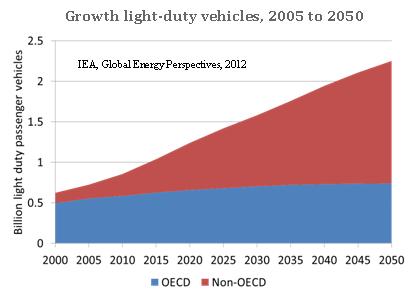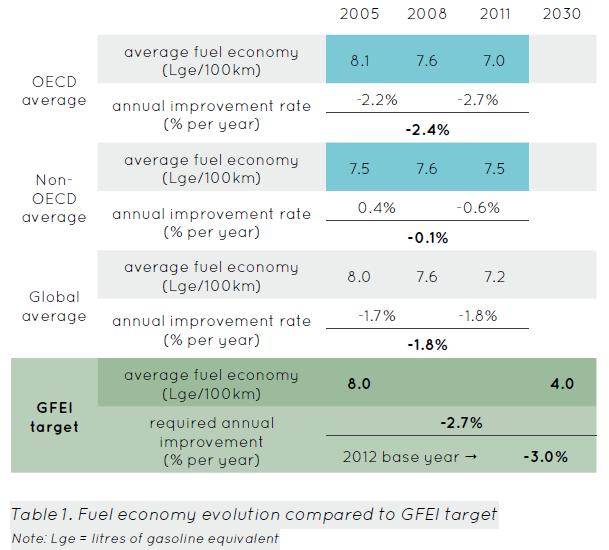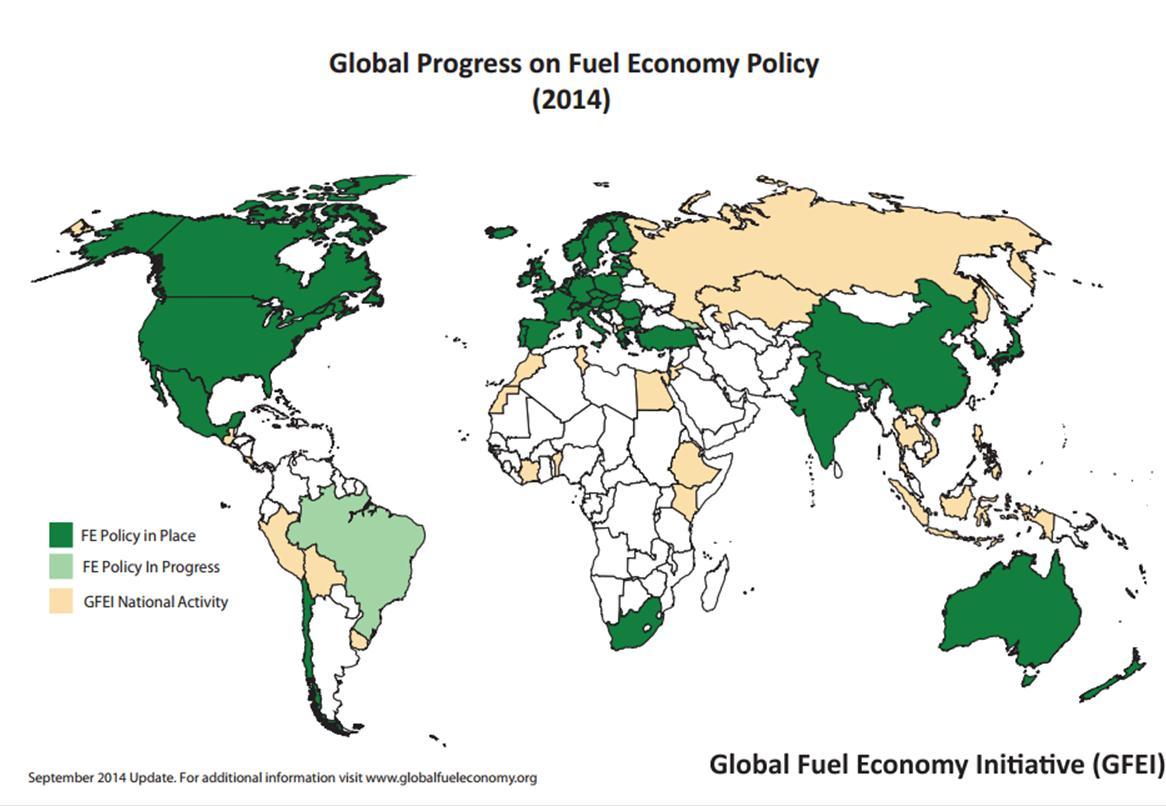Doubling the efficiency of the global vehicle fleet
The global vehicle fleet is set to grow to at least double its present size, and almost all growth will be in low and middle income countries. This will result in major increases in climate and air pollution emissions. To stabilise emissions the global fleet’s fuel efficiency needs to double. While developed countries are on track to achieve this, most developing countries are not making progress. The Global Fuel Economy Initiative (GFEI) is supporting countries to put in place policies that promote cleaner and more efficient vehicles. This has major climate, health and economic benefits.

Today there are about 1 billion vehicles on our roads. Two-thirds of these are found in OECD countries. But as people in low and middle income countries get more disposable income, owning a private vehicle is on top of their list. Predictions show that the global fleet will at least double, maybe even triple – and that almost all of that growth will take place in non-OECD countries. Actually the non-OECD fleet could increase five- or even tenfold. As a result, close to three-quarters of the global fleet is predicted to be found in non-OECD countries by 2050.
It is crucial that the world develops new mobility models that do not depend on individual car use, through better urban planning, public transport, cycling and walking, etc. However, in any scenario we see a massive increase in the global fleet. This means we also need to ensure we improve the vehicles.
Today the transport sector is responsible for one-quarter of global energy-related climate emissions. This is set to increase to one-third, growing more rapidly than any other sector. Other impacts include air pollution, dependency on fossil fuels and energy use, and congestion.
Vehicle emissions – the good and bad news
If we could double the efficiency of the average car – going from about 8 litres per 100km today to 4 litres per 100km – we could stabilise the CO2 emissions of the global fleet.
The good news is that this is what is happening in OECD countries. We are experiencing an unprecedented improvement in fuel economy around the world. The US, EU, Japan and others are on the way to achieving this target of doubling the efficiency of their fleet by 2030.

However, low and middle income countries are lagging behind – most non-OECD countries are making little improvement in the efficiency of their fleet. Interestingly even countries fully dependent on OECD car imports also do not improve their fuel economy. So that means that the technology is available but the policies are not in place to make use of this. Only a few developing countries have policies in place that incentivise more efficient and cleaner cars.
A small window of major opportunity
We need to ensure that the right policies and incentives are in place so that non-OECD countries improve their fuel economy and get the benefits that stem from this: not only air quality and climate benefits, but also economic benefits due to reduced fuel consumption. We only have a small window of opportunity to get these policies in place before fleets will have grown out of hand – maybe five to eight years.
Nairobi, the capital of Kenya, is set to have more residents than London by 2030. Nairobi’s car fleet is doubling in size every six years. Kenya imports its vehicles mainly from Japan, and most are used vehicles of five to eight years old. The average fuel economy of its fleet has been stable at about 7.7 litres per 100km.
While cars coming in are increasingly more efficient, vehicle size is also going up. Kenya is now working with UNEP to 
Costs and benefits
Doubling the efficiency of the global fleet will have major climate benefits – it would reduce emissions of CO2 by over 1 gigatonne (Gt) a year by 2025, and over 2 Gt/yr by 2050, and result in savings in annual oil import bills alone worth over US$300 billion in 2025 and US$600 billion in 2050 (based on an oil price of US$100 a barrel).
The introduction of cleaner and more efficient vehicles worldwide is also essential to improve the rapidly deteriorating air quality in cities around the world. The WHO estimates that air pollution prematurely kills 7 million people per year, more than any other pollutant, and global vehicle emissions are a major contributor.
There are few measures more cost effective to reduce climate emissions than improving the efficiency of vehicles. The benefits of the light-duty vehicle fuel economy standards in the US are estimated at US$11.9 billion per year, while the costs are estimated at US$3.3 billion, with CO2 reductions of 54 million tonnes of CO2/yr. In the EU, fuel economy policies have seen CO2 emissions go down from 140 g/km in 2008 to 120 g/km in 2012, giving a total reduction of 14.4 million tonnes a year in 2012 (set to grow to 54 million tonnes a year by 2020).
China has introduced a fuel economy policy that has saved it close to US$5 billion from 2006 to 2011, reducing CO2 emissions by more than 13 million tonnes. If other big south-east Asian countries – Indonesia, Philippines, Thailand, and Vietnam – were to introduce fuel economy policies, it is estimated that this could reduce their fleet’s CO2 emissions by 27 per cent by 2035.
A global effort to improve fuel economy
In 2009 the Global Fuel Economy Initiative (GFEI) was launched, aiming at least to double the efficiency of the global fleet from an average of 8 litres/100km (2005) to 4 litres/100km – based on IPCC and G8 targets and recommendations. The GFEI is implemented by leading global organisations – the International Energy Agency, the International Transport Forum, the FIA Foundation, UC Davis University, the International Council for Clean Transportation and the UN Environment Programme.
The Advisory Group of the GFEI includes the global oil and vehicles industry, major NGOs and international experts. To achieve these objectives, countries need to urgently adopt measures that will see a significant improvement of fuel efficiency.
Measures successfully deployed, among others, include import regulation of old vehicles, emissions standards, fiscal measures (reducing taxes on efficient vehicles and increasing taxes on inefficient vehicles), labelling (standardised labelling indicating efficiency of cars in showrooms), removal of the oldest vehicles (rebate or ‘cash for clunkers’ schemes) and removal of fuel subsidies.
Support to the GFEI is provided by the European Union, the Global Environment Facility, the UN Environment Programme and the FIA Foundation, among others, to the tune of nearly US$9 million

Many country projects include components for the introduction of zero and low emission vehicles, such as hybrid and electric vehicles. While it is estimated that for the coming decade the major emissions reduction from the global fleet needs to be achieved through improving fuel efficiency, new technologies can help make further progress; this would go beyond levelling the emissions of the global fleet and start making an overall reduction.
Support to the GFEI is provided by the European Union, the Global Environment Facility, the UN Environment Programme and the FIA Foundation, among others, to the tune of nearly US$9 million.
Scaling Up
The world is to invest US$400 trillion buying cars and the fuels to run them from now until 2050. That is 25 times the GDP of today’s EU. It is important that these vehicles will be added in countries that promote cleaner and more efficient vehicles. The objective of the GFEI is to do exactly that – support all countries in the world adopt a clean and efficient vehicles policy.
The GFEI is monitoring trends at global and national level, creating awareness, and supporting regional and national action
The GFEI is monitoring trends at global and national level, creating awareness, and supporting regional and national action. At the moment close to 20 country programmes are being supported in Africa, Asia, Latin America, and Middle East that are developing fuel economy polices. A similar number have expressed interest to work with the GFEI. We are convinced that this will result in a critical mass and will see all countries worldwide adopt fuel economy policies.








